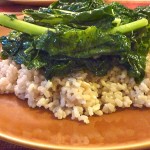by Valerie Love
For most transplants to New Zealand, the first words they learn in Maori are “Kia ora” (hello) or “Haere mai” (welcome).
But for me, it was “puku”, which means belly or abdomen.
Although I’m originally from the United States, my partner is from Wellington. And from the very start of our relationship, she’s always asked me, “How’s puku?” as a way of checking in on how I’m doing as a whole.
And it’s an important question. Because the answer to “How’s puku?” reveals so much more than just what my stomach is up to.
The chakra systems states that the belly is the space that holds the seeds of personal power – our strength, confidence, and enthusiasm are all reflected in Manipura chakra, the third energy centre in the body.
Patanjali expresses the connection between the belly and the body as a whole in Book III, Verse 30 of the Yoga Sutras:
“Understanding of the navel centre yields understanding of all bodily systems.
For as long as I can remember, my stomach has called the shots. I’ve struggled with a sensitive stomach and chronic stomachaches since childhood.
Without even realizing it at the time, I instinctively turned to meditation to get through periods of acute stomach distress. The only thing that made my sensitive stomach settle was to stop whatever I was doing and go lie down for a while. Unbeknownst to me at the time, lying on the cot in the nurse’s office at school, I created what was essentially a precursor to the simplified, quiet space of my yoga and meditation practice as an adult.
Alone in the nurse’s office, I could let go of outside distractions, either by closing my eyes, or focusing on just the curtain in front of me. In those moments, there was nothing to do but lie down and breathe. And in most cases, the stomachache would go away after 30 minutes or so, and I’d return to the classroom with my peers.
On the doctor’s advice, I began keeping a food journal, and discovered a number of consistent trigger foods: red meat, fried foods, and drinking chocolate, among others. As I began to eliminate these foods from my diet, my stomachaches eventually started to decrease, but would come back with a vengeance during periods of stress or uncertainty in my life.
Over time, it became clear to me that my stomachaches were more than just a result of what I did or didn’t eat. My entire mental state was being manifested physically through my stomach. Stress, anxiety, fear or uncertainty in my life would inevitably trigger a stomachache, sometimes before my brain was even cognizant of it.
Around the time that I began practicing yoga steadily at age 25, the stomachaches started to taper off. As I started to study yogic philosophy and ayurveda, I began to understand the impact of various energies on the body. My asana practice strengthened a weak third chakra and gave me more confidence. As I began to tune in and really listen to the puku, I was able to recognize and calm the rajasic energy and lifestyle that it was so sensitive to.
Now I rarely get stomachaches anymore. And when I do experience one, I have the tools in my yoga and meditation practice to sit with it, and to listen to what my puku is trying to tell me.
The Gunas
The gunas are the three qualities or tendencies of the mind and body. Although we may feel one more acutely than the others at any given time, all three qualities reside within us and compose our prakriti, or our nature.
The three gunas are:
- Rajas
- Tamas
- Sattva
Rajas is the active energy within us. It’s the “get up and go” quality associated with action, passion, and creation, but also with restlessness and agitation. A rajasic mind races from thought to thought, and an overly rajasic body may have difficulty sitting still.
Tamas, on the other hand, is the opposite: the quality of stillness, inertia, or dullness. A tamasic mind may be resistant to change or to new ideas. Tamas isn’t all bad—it is needed to calm the body and mind when over-stimulated, or to dull the senses during periods of extreme stress or physical pain. However, when tamas is out of balance, it can lead to indifference, fatigue, and depression in the body and mind.
Sattva, the third of the gunas, is the quality of clarity, balance, steadiness, and light. Sattva promotes love, peace, fulfillment, and health. Sattva is guided by simplicity, and letting go of material attachments.
The gunas apply not just to our mental and physical state, but also apply to the foods that we eat. As the book, Eat Taste Heal: An Ayurvedic Guidebook and Cookbook for Modern Living explains:
The gunas offer incredible insight into the subtle effects of food on the mind. When used within the greater context of individual constitutions, the knowledge of these qualities enhances our abilities to choose healing foods. These qualities also extend to the methods in which foods are farmed, prepared, and consumed.
Rajasic foods are stimulating by nature. Rajasic foods include coffee, soda, and other beverages containing caffeine or stimulants. Chocolate, garlic, lemon, vinegar, eggs, avocados, tomatoes, peanuts, and spicy foods, particularly those with black pepper and chilli are also considered rajasic. In moderation they provide energy and promote digestive fire. In excess, they can create digestive and other imbalances in the body, as well as heighten agitation and irritability.
Rajasic foods are not inherently bad, and are in fact a necessary part of one’s diet. I eat both eggs and avocados quite regularly for exactly the reason that they do provide me with energy and stamina. And my partner would most likely cease to function without her morning cup of coffee! But it is worth noting that after a stressful day at the office, a bowl of super spicy curry for dinner isn’t going to help you unwind and have a good night’s sleep!
Tamasic foods include meat, fish, alcohol, onions, cheese, margarine, white mushrooms, deep-fried foods, and foods containing preservatives. Any food that is processed or from a box is inherently a tamasic food, since it’s not fresh and vibrant. Tamasic foods are harder for the body to digest than sattvic and rajasic foods, and thus require more energy for the body to process. And even after the body breaks down these foods, they don’t offer the nourishment that the body seeks. This can result in a sense of heaviness, or dullness after meals, rather than a feeling of energy and vibrancy.
Sattvic foods are foods that create balance and well being, and include fresh fruits and vegetables (without pesticides), nuts, legumes, whole grains including rice, spelt, oats, and barley. Honey is considered a sattvic sweetener (although it should never be used for baking or added to boiling water, which kills the enzymes in honey that allow the body to digest it). Ghee (Indian clarified butter) and fresh unprocessed yoghurt are also sattvic foods. Additionally, mild spices and fresh herbs like basil, cardamom, cinnamon, coriander, cumin, fennel, fenugreek, ginger, parsley, and turmeric can have sattvic qualities. Sattvic foods can have a rejuvenating effect on the body, and often help to calm the body and mind.
It’s important to find the right mix of sattvic and rajasic foods, and this balance is different for everyone. I was a proper vegetarian for 14 years but discovered over time that eating fish once or twice a week gave me much more energy and made me feel physically better than a strictly vegetarian diet. And yet fish is supposedly a tamasic food!
As always, there are no hard and fast rules about what to eat, but rather the opportunity to explore and cultivate a better understanding of what foods nourish your body and spirit.
When my partner and I first moved in together, although we had similar approaches to food and a general desire to eat predominately fresh, homemade, and unprocessed foods, we discovered significant differences to what comprised a nourishing meal for each of us. While my nervous stomach is calmed by eating predominantly sattvic foods, the sweetness of many sattvic foods doesn’t work as well for my partner, who flourishes with a greater amount of rajasic foods than what works for me. (We’ll explore the different doshas, or constitutions, and their influence on the way we eat in the next column—stay tuned!)
In the meantime, I invite you to take a moment to observe your current energy state before preparing a meal, and again after you eat. If the body and mind are feeling rajasic, look for soothing, sattvic foods to promote calm and balance. If you’re feeling lethargic, try adding a bit of spice and heat to build the energy back up.
And if your puku is trying to tell you something, take a moment to listen.



[…] “How’s Puku: Unlock the Wisdom of the Belly” is my latest Yoga on a Plate column for the Yoga Lunchbox. “Puku” is the Maori word for belly, and “How’s puku?” is a phrase that Laura often asks me. The article came out while I was offline traveling, which is why I’m just posting it here now, but do go check it out! […]